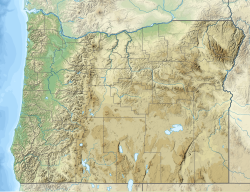This article needs additional citations for verification .(June 2020) |
| Gable Creek Formation | |
|---|---|
| Stratigraphic range: Albian ~ | |
| Type | Geological formation |
| Unit of | Mitchell Group |
| Lithology | |
| Primary | Sandstone, conglomerate |
| Location | |
| Coordinates | 44°30′N120°06′W / 44.5°N 120.1°W |
| Region | Oregon |
| Country | United States |
| Extent | Wheeler County |
| Type section | |
| Named for | Gable Creek |
The Gable Creek Formation is a sedimentary rock formation from the Albian age of the Early Cretaceous. [1] The formation is in Wheeler County, Oregon of the United States of America and is intertongued with the similarly aged Hudspeth Formation. The formation mostly consists of fluvial-deltaic sandstones and conglomerates. [2] Marine fossils can be found throughout the formation including various species of ammonites, clams and other mollusks. The Gable Creek Formation gets its name from Gable Creek, a creek that runs through much of the formation.




